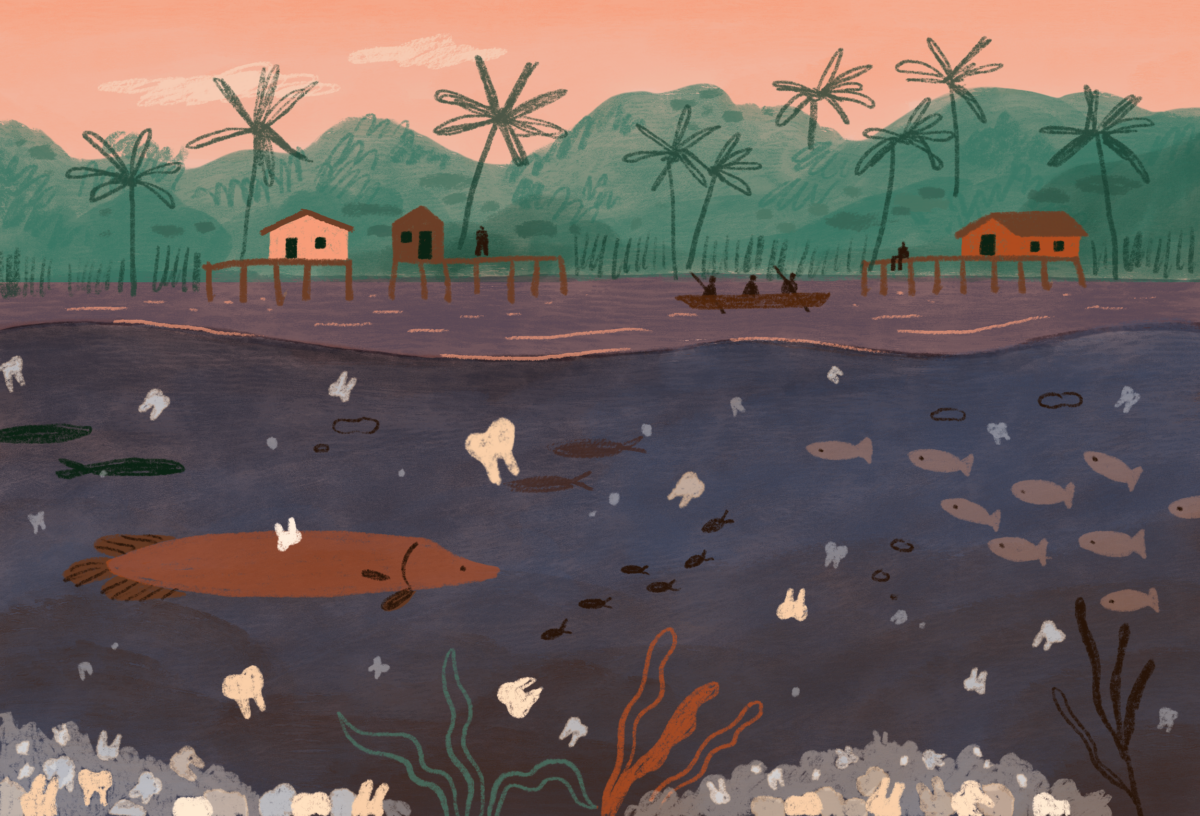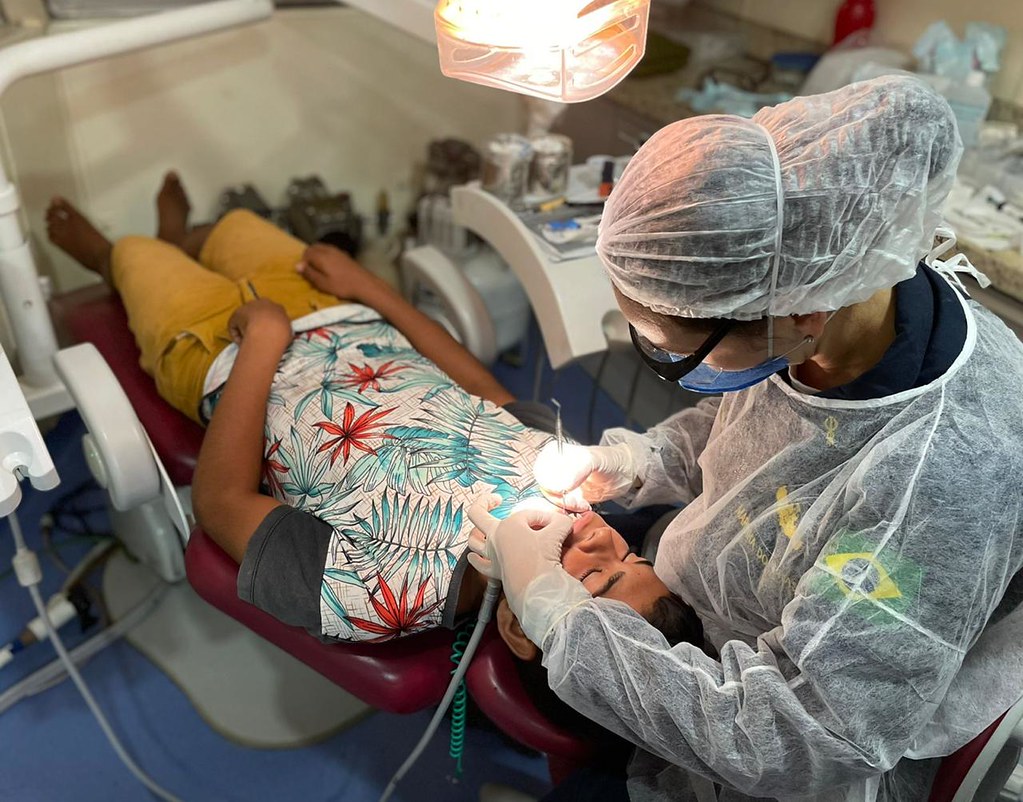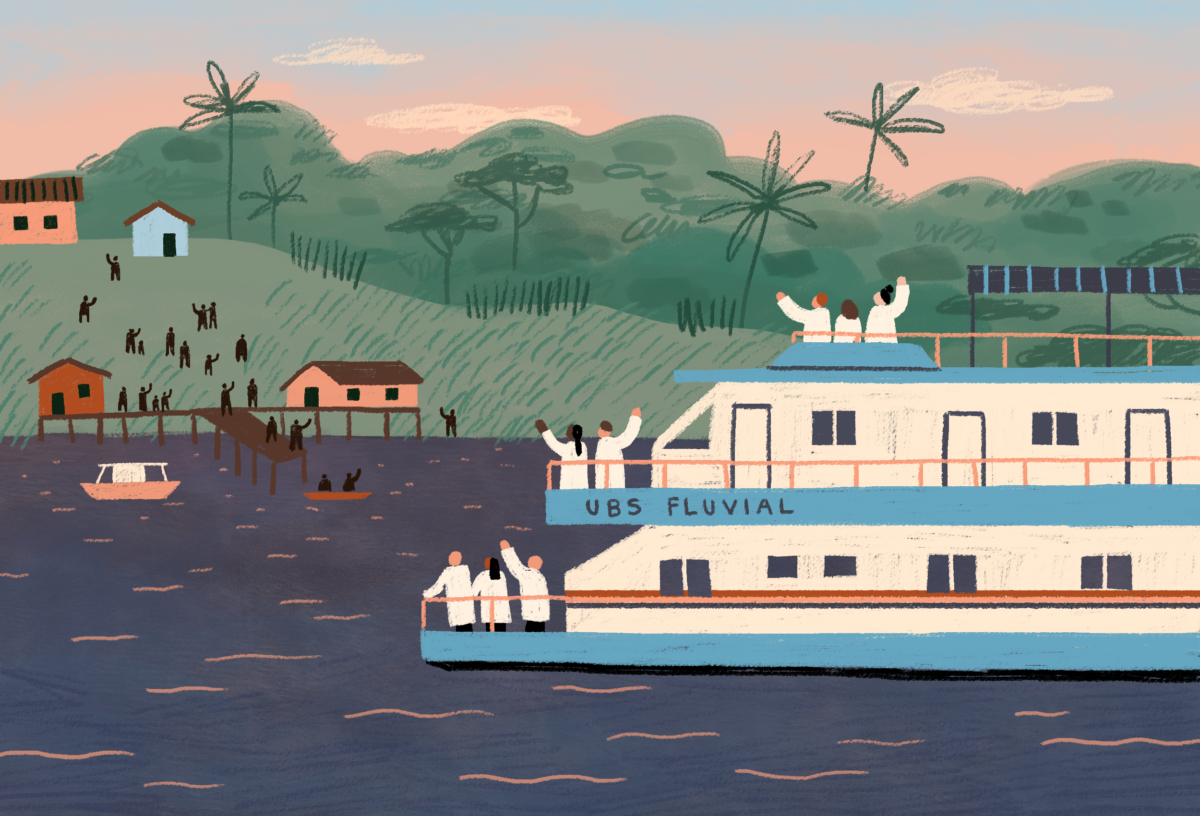 #News
#News
The challenges of accessing oral healthcare in Amazonas
Almost a quarter of the people living on the banks of the Rio Negro have not been to the dentist in the last three years; some have never had access to dental services in their lives, study finds
 Illustrations: Bruna Martins/Estúdio Voador
Illustrations: Bruna Martins/Estúdio Voador
Approximately a quarter of the people living in riverside communities in rural Manaus have not seen a dentist in the last three years—some have never in their lives had access to dental services, despite the federal government’s efforts to send health teams to remote and difficult-to-access areas across Brazil.
These are the findings of a study published in the journal Rural Remote Health in January by researchers from the Leônidas & Maria Deane Institute at the Oswaldo Cruz Foundation (FIOCRUZ), the Federal University of Amazonas (UFAM), and the State University of Amazonas (UEA).
The team interviewed 492 people from 38 communities on the left bank of the Rio Negro. The objective was to determine the socioeconomic and health profile of these populations, the frequency with which they use dental services, and the difficulties they face in accessing them.
It is important to identify the factors that affect access to oral health in these communities because this information can be used in the development or improvement of health promotion strategies in other economically isolated or semi-isolated communities with similar social and cultural characteristics.
The communities studied are located in areas covered by primary healthcare boats, vessels adapted to function as mobile health centers. The boats periodically visit riverside communities in isolated and difficult-to-access areas of the Amazon and the Pantanal in Mato Grosso do Sul.
Each vessel carries at least one doctor, one nurse, one nursing technician or assistant, one dental surgeon, and one oral health technician or assistant.
Established by the Brazilian Ministry of Health as part of its national oral health policy in 2004, the strategy has advanced oral health coverage as part of primary care in Brazil, helping to reduce inequalities in access to healthcare in remote areas of the country.
It also reinforced the importance of investing in healthcare approaches targeted at specific groups that have historically been excluded from health services.
Despite the progress, approximately 22% of respondents said they had last used oral health services more than three years ago, while 3.1% had never been to the dentist.
Of those who sought out dental care in recent years, 36.9% did so for prevention; another 22.4% because they were experiencing pain, and 20.6% because they needed to have a tooth extracted.
The researchers found that 34.4% of the individuals interviewed had lost more than 12 teeth and 10.4% had lost all of their teeth.
The results are in line with national data. A study published in the journal Community Dentistry and Oral Epidemiology in 2022, based on data from the Brazilian population, found that 48.4% of people aged 18 or over last visited the dentist more than a year ago and 2% had never been.
The pattern is different when it comes to the use of public dental services. “Only 23.1% of the Brazilian population used public services for their last consultation, contrary to what was observed among riverside populations, for whom public services were the main form of access to oral healthcare, suggesting that it needs to be reinforced and expanded in these regions,” explains dental surgeon Maria Helena Rodrigues Galvão, a professor at the Federal University of Pernambuco (UFPE) and one of the authors of the article published in Community Dentistry and Oral Epidemiology.
Oral problems have social and economic roots
In the Rural Remote Health study,more than half of those interviewed (58.7%) reported having only completed elementary education, while 12% had never attended school. The family income of just over half of the people living in these communities (53.4%) was lower than the minimum wage.
“Lower education levels and income are usually associated with a lower use of health services in general, and there is evidence that this relationship is even more notable in rural areas,” highlights dental surgeon Diego Cordeiro, who is studying a PhD in public health at UFAM and was one of the authors of the article.
According to Galvão, the study’s findings reinforce the notion that oral problems have deep social and economic roots.
“Cultural and geographical factors are also highly associated with patterns in health conditions, as well as the subjective recognition of the disease,” notes the UFPE researcher.
In the case of riverside populations, this situation is worsened by the fact that they live in very isolated areas. People in these communities often need to travel for up to 30 hours—depending on weather and water conditions—to the nearest city to access health services.
Most avoid long trips to urban areas due to transportation costs and travel times. Those who take the risk often arrive late for appointments, which are based on a first-come, first-serve basis, yet still need to bear the extra costs of transportation, accommodation, and food.

Most of the time, the only remaining option is the services provided by the primary healthcare boats, which have helped promote access to oral health and reduced health inequalities in these regions.
“However, our results suggest that the services they offer still focus primarily on solving problems, such as toothaches or extractions, rather than prevention,” says UFAM’s Cordeiro.
“The healthcare model needs to evolve beyond the traditional model, incorporating more comprehensive health promotion strategies and encouraging the adoption of healthy choices in order to reduce the occurrence of injuries and transform the need for oral health services,” Cordeiro adds.
The obstacles are enormous, according to Fernanda Campos de Almeida Carrer, a professor at the School of Dentistry of the University of São Paulo (USP) and a researcher at the Observatory of Human Resources in Dentistry and the Ibero-American Observatory of Public Oral Health Policy.
“The primary healthcare boats are important, but they do not cover all communities,” she states. “Some are so isolated that it is almost impossible to reach them, especially when river levels are low.”
For this report, we asked the Amazonas State Health Department whether it plans to expand the provision of healthcare boats in the region, but it did not respond.
Difficulties retaining professionals
The strategy is also ineffective when it comes to cases that require long-term treatment, since regular monitoring is almost impossible—it can take up to 30 days for a vessel to travel to and from a community.
It is also very difficult to attract and retain healthcare professionals in these regions, which have been called “medical voids.”

“New graduates are more interested in working in isolated or difficult-to-access locations, but they soon change their minds when they realize how little support and technical guidance they receive to help them,” explains USP’s Carrer.
In recent years, she and other researchers from the Observatory of Human Resources in Dentistry have been gathering evidence to support the development of strategies to attract and retain more health professionals in these regions.
“We have seen that there is no point in just offering a high salary. Without technical support and infrastructure, we will continue to have difficulty attracting people to the job,” says the researcher.
She believes that the government needs to invest in more complete packages.
“We are talking about training courses and technical support, which would give these individuals remote access to professionals with more experience, to ask questions or seek guidance in relation to certain procedures and treatments for specific cases,” suggests Carrer. “It’s not only a question of money. Other things matter too.”
At the same time, Carrer emphasizes, it is equally important to create favorable conditions for the families of these professionals, so that they feel more comfortable moving to regions far from urban centers.
“Some countries even grant scholarships to the children of these workers or subsidize their housing costs, among other advantages,” she highlights.
Such measures usually remain valid for a period of approximately two years. “Even with incentives, many decide to move or return to cities with more infrastructure,” says Carrer.
“There is no problem with this happening, as long as public policies exist that ensure these professionals are replaced and health coverage in the region is maintained.”
*
This article may be republished online under the CC-BY-NC-ND Creative Commons license.
The text must not be edited and the author(s) and source (Science Arena) must be credited.
News
 #News
#News
 #News
#News
 #News
#News
